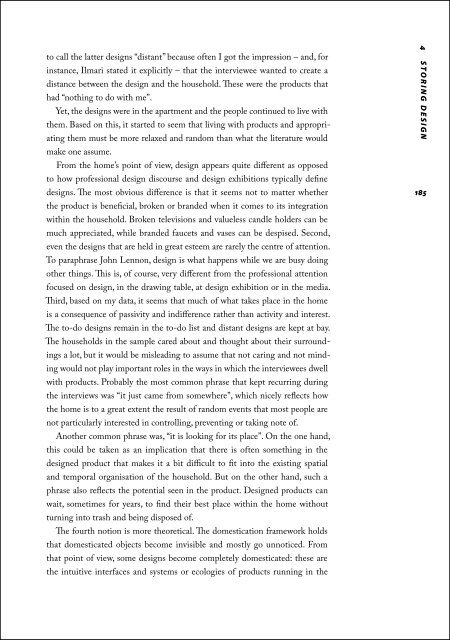Lataa ilmaiseksi
Lataa ilmaiseksi
Lataa ilmaiseksi
Create successful ePaper yourself
Turn your PDF publications into a flip-book with our unique Google optimized e-Paper software.
to call the latter designs “distant” because often I got the impression – and, for<br />
instance, Ilmari stated it explicitly – that the interviewee wanted to create a<br />
distance between the design and the household. These were the products that<br />
had “nothing to do with me”.<br />
Yet, the designs were in the apartment and the people continued to live with<br />
them. Based on this, it started to seem that living with products and appropriating<br />
them must be more relaxed and random than what the literature would<br />
make one assume.<br />
From the home’s point of view, design appears quite different as opposed<br />
to how professional design discourse and design exhibitions typically define<br />
designs. The most obvious difference is that it seems not to matter whether<br />
the product is beneficial, broken or branded when it comes to its integration<br />
within the household. Broken televisions and valueless candle holders can be<br />
much appreciated, while branded faucets and vases can be despised. Second,<br />
even the designs that are held in great esteem are rarely the centre of attention.<br />
To paraphrase John Lennon, design is what happens while we are busy doing<br />
other things. This is, of course, very different from the professional attention<br />
focused on design, in the drawing table, at design exhibition or in the media.<br />
Third, based on my data, it seems that much of what takes place in the home<br />
is a consequence of passivity and indifference rather than activity and interest.<br />
The to-do designs remain in the to-do list and distant designs are kept at bay.<br />
The households in the sample cared about and thought about their surroundings<br />
a lot, but it would be misleading to assume that not caring and not minding<br />
would not play important roles in the ways in which the interviewees dwell<br />
with products. Probably the most common phrase that kept recurring during<br />
the interviews was “it just came from somewhere”, which nicely reflects how<br />
the home is to a great extent the result of random events that most people are<br />
not particularly interested in controlling, preventing or taking note of.<br />
Another common phrase was, “it is looking for its place”. On the one hand,<br />
this could be taken as an implication that there is often something in the<br />
designed product that makes it a bit difficult to fit into the existing spatial<br />
and temporal organisation of the household. But on the other hand, such a<br />
phrase also reflects the potential seen in the product. Designed products can<br />
wait, sometimes for years, to find their best place within the home without<br />
turning into trash and being disposed of.<br />
The fourth notion is more theoretical. The domestication framework holds<br />
that domesticated objects become invisible and mostly go unnoticed. From<br />
that point of view, some designs become completely domesticated: these are<br />
the intuitive interfaces and systems or ecologies of products running in the<br />
4 S T O R I N G D E S I G N<br />
185
















